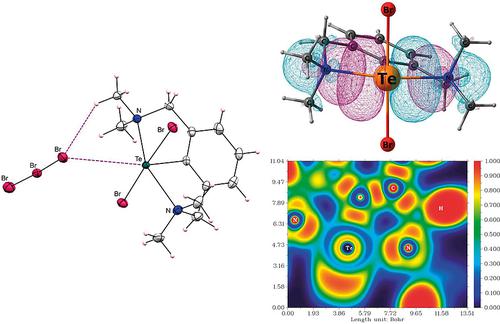当前位置:
X-MOL 学术
›
Eur. J. Inorg. Chem.
›
论文详情
Our official English website, www.x-mol.net, welcomes your
feedback! (Note: you will need to create a separate account there.)
Halogenation of Diorganotelluride [2,6‐(Me2NCH2)2C6H3]TenBu: Synthesis, Molecular and Electronic Structural Investigation of Monoorgano Dihalotelluronium(IV) Cation
European Journal of Inorganic Chemistry ( IF 2.2 ) Pub Date : 2020-10-23 , DOI: 10.1002/ejic.202000910 Rajesh Deka 1 , Anand Gupta 1 , Arup Sarkar 1 , Ray J. Butcher 2 , Harkesh B. Singh 1
European Journal of Inorganic Chemistry ( IF 2.2 ) Pub Date : 2020-10-23 , DOI: 10.1002/ejic.202000910 Rajesh Deka 1 , Anand Gupta 1 , Arup Sarkar 1 , Ray J. Butcher 2 , Harkesh B. Singh 1
Affiliation

|
A simple methodology for the synthesis of heteroleptic diorganotelluride [2,6‐(Me2NCH2)2C6H3]TenBu (1) and homoleptic diorganotelluride [2,6‐(Me2NCH2)2C6H3]2Te (2) is reported. The halogenation reactions of diorganotelluride 1 are studied. In particular, the reaction of 1 with Br2 resulted in the isolation of a monoorgano dibromotelluronium(IV) cation, namely [2,6‐(Me2NCH2)2C6H3TeBr2]·Br3 ([3]·Br3). The reaction of [3]·Br3 with K2PdCl4 afforded a monoorgano mixed dihalotelluronium(IV) cation, [2,6‐(Me2NCH2)2C6H3TeClBr]·PdBr4 ([4]·PdBr4). When diorganotelluride 1 was treated with I2, the reaction afforded the tellurenium(II) cation, [2,6‐(Me2NCH2)2C6H3Te]·I2·I3 ([5]·I2·I3). The reaction of 1 with HgCl2 resulted in the isolation of dimeric diorganoditelluroxonium(IV) cation, [2,6‐(Me2NCH2)2C6H3Te(µ‐O)]2·Hg2Cl6 ([6]·Hg2Cl6). A similar diorganoditelluroxonium(IV) cation, namely [2,6‐(Me2NCH2)2C6H3Te(µ‐O)]2·2Br ([6]·2Br) was also obtained by the reaction of 1 with Br2 and NaOH. The crystallographic studies suggest that for each compound, both the N atoms from the pendant arms make strong Intramolecular Chalcogen Bonding (IChB) interactions with the Te center(s). The presence of a strong N→Te IChB interaction in the synthesized compounds was further validated by DFT calculations.
中文翻译:

Diorganotelluride [2,6-(Me2NCH2)2C6H3] TenBu的卤化:单有机二卤代尿烷(IV)阳离子的合成,分子和电子结构研究
一种简单的合成杂多香二有机碲化物[2,6-(Me 2 NCH 2)2 C 6 H 3 ] Te n Bu(1)和同型二香有机碲化物[2,6–(Me 2 NCH 2)2 C 6 H的简单方法3 ] 2 Te(2)被报道。研究了二有机碲化物1的卤化反应。特别是1与Br 2的反应导致了单有机二溴碲化铵(IV)阳离子的分离,即[2,6-(Me 2 NCH2)2 C 6 H 3 TeBr 2 ] · Br 3([3]·Br 3)。的反应[3]·溴3具有K 2的PdCl 4,得到一个monoorgano混合dihalotelluronium(IV)阳离子,[2,6-(ME 2 NCH 2)2 C ^ 6 ħ 3 TeClBr] · PDBR 4([4]· PdBr 4)。当diorganotelluride 1用I处理2,将反应得到tellurenium(II)阳离子,[2,6-(ME2 NCH 2)2 C 6 H 3 Te] · I 2 · I 3([5]·I 2 ·I 3)。1与HgCl 2的反应导致分离出二聚二有机二碲氧杂鎓(IV)阳离子[2,6-(Me 2 NCH 2)2 C 6 H 3 Te(µ‐O)] 2 · Hg 2 Cl 6([ 6]·Hg 2 Cl 6)。通过1的反应也得到了类似的二有机二铁氧杂鎓(IV)阳离子,即[2,6-(Me 2 NCH 2)2 C 6 H 3 Te(µ-O)] 2 · 2Br([6]·2Br)。用Br 2和NaOH。晶体学研究表明,对于每种化合物,悬垂臂上的两个N原子都与Te中心形成强烈的分子内硫族元素键(IChB)相互作用。通过DFT计算进一步验证了合成化合物中强N→Te IChB相互作用的存在。
更新日期:2020-11-23
中文翻译:

Diorganotelluride [2,6-(Me2NCH2)2C6H3] TenBu的卤化:单有机二卤代尿烷(IV)阳离子的合成,分子和电子结构研究
一种简单的合成杂多香二有机碲化物[2,6-(Me 2 NCH 2)2 C 6 H 3 ] Te n Bu(1)和同型二香有机碲化物[2,6–(Me 2 NCH 2)2 C 6 H的简单方法3 ] 2 Te(2)被报道。研究了二有机碲化物1的卤化反应。特别是1与Br 2的反应导致了单有机二溴碲化铵(IV)阳离子的分离,即[2,6-(Me 2 NCH2)2 C 6 H 3 TeBr 2 ] · Br 3([3]·Br 3)。的反应[3]·溴3具有K 2的PdCl 4,得到一个monoorgano混合dihalotelluronium(IV)阳离子,[2,6-(ME 2 NCH 2)2 C ^ 6 ħ 3 TeClBr] · PDBR 4([4]· PdBr 4)。当diorganotelluride 1用I处理2,将反应得到tellurenium(II)阳离子,[2,6-(ME2 NCH 2)2 C 6 H 3 Te] · I 2 · I 3([5]·I 2 ·I 3)。1与HgCl 2的反应导致分离出二聚二有机二碲氧杂鎓(IV)阳离子[2,6-(Me 2 NCH 2)2 C 6 H 3 Te(µ‐O)] 2 · Hg 2 Cl 6([ 6]·Hg 2 Cl 6)。通过1的反应也得到了类似的二有机二铁氧杂鎓(IV)阳离子,即[2,6-(Me 2 NCH 2)2 C 6 H 3 Te(µ-O)] 2 · 2Br([6]·2Br)。用Br 2和NaOH。晶体学研究表明,对于每种化合物,悬垂臂上的两个N原子都与Te中心形成强烈的分子内硫族元素键(IChB)相互作用。通过DFT计算进一步验证了合成化合物中强N→Te IChB相互作用的存在。











































 京公网安备 11010802027423号
京公网安备 11010802027423号